Electrical telegraph
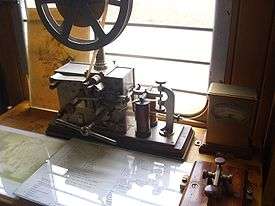
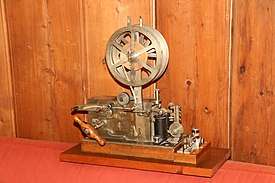
An electrical telegraph is a telegraph that uses electrical signals, usually conveyed via dedicated telecommunication circuit or radio.
The electrical telegraph, or more commonly just telegraph, superseded optical semaphore telegraph systems, thus becoming the first form of electrical telecommunications. In a matter of decades after their creation in the 1830s, electrical telegraph networks permitted people and commerce to transmit messages across both continents and oceans almost instantly, with widespread social and economic impacts.
History
Early work

From early studies of electricity, electrical phenomena were known to travel with great speed, and many experimenters worked on the application of electricity to communications at a distance.
All the known effects of electricity - such as sparks, electrostatic attraction, chemical changes, electric shocks, and later electromagnetism - were applied to the problems of detecting controlled transmissions of electricity at various distances.
In 1753, an anonymous writer in the Scots Magazine suggested an electrostatic telegraph. Using one wire for each letter of the alphabet, a message could be transmitted by connecting the wire terminals in turn to an electrostatic machine, and observing the deflection of pith balls at the far end.[1] Telegraphs employing electrostatic attraction were the basis of early experiments in electrical telegraphy in Europe, but were abandoned as being impractical and were never developed into a useful communication system.
In 1774, Georges-Louis Le Sage realised an early electric telegraph. The telegraph had a separate wire for each of the 26 letters of the alphabet and its range was only between two rooms of his home.[2]
In 1800, Alessandro Volta invented the voltaic pile, allowing for a continuous current of electricity for experimentation. This became a source of a low-voltage current that could be used to produce more distinct effects, and which was far less limited than the momentary discharge of an electrostatic machine, which with Leyden jars were the only previously known man-made sources of electricity.
Another very early experiment in electrical telegraphy was an 'electrochemical telegraph' created by the German physician, anatomist and inventor Samuel Thomas von Sömmering in 1809, based on an earlier, less robust design of 1804 by Spanish polymath and scientist Francisco Salva Campillo.[3] Both their designs employed multiple wires (up to 35) to represent almost all Latin letters and numerals. Thus, messages could be conveyed electrically up to a few kilometers (in von Sömmering's design), with each of the telegraph receiver's wires immersed in a separate glass tube of acid. An electric current was sequentially applied by the sender through the various wires representing each digit of a message; at the recipient's end the currents electrolysed the acid in the tubes in sequence, releasing streams of hydrogen bubbles next to each associated letter or numeral. The telegraph receiver's operator would watch the bubbles and could then record the transmitted message.[3] This is in contrast to later telegraphs that used a single wire (with ground return).
Hans Christian Ørsted discovered in 1820 that an electric current produces a magnetic field which will deflect a compass needle. In the same year Johann Schweigger invented the galvanometer, with a coil of wire around a compass, which could be used as a sensitive indicator for an electric current. In 1821, André-Marie Ampère suggested that telegraphy could be done by a system of galvanometers, with one wire per galvanometer to indicate each letter, and said he had experimented successfully with such a system. In 1824, Peter Barlow said that such a system only worked to a distance of about 200 feet (61 m), and so was impractical.[4]
In 1825, William Sturgeon invented the electromagnet, with a single winding of uninsulated wire on a piece of varnished iron, which increased the magnetic force produced by electric current. Joseph Henry improved it in 1828 by placing several windings of insulated wire around the bar, creating a much more powerful electromagnet which could operate a telegraph through the high resistance of long telegraph wires.[5] During his tenure at The Albany Academy from 1826 to 1832, Henry first demonstrated the theory of the 'magnetic telegraph' by ringing a bell through a mile (1.6 km) of wire strung around the room.[6]
In 1835, Joseph Henry and Edward Davy invented the critical electrical relay. Davy's relay used a magnetic needle which dipped into a mercury contact when an electric current passed through the surrounding coil.[7] This allowed a weak current to switch a larger current to operate a powerful local electromagnet over very long distances.[8][9] Davy demonstrated his telegraph system in Regent's Park in 1837 and was granted a patent on 4 July 1838. He also developed an electric relay.[10]
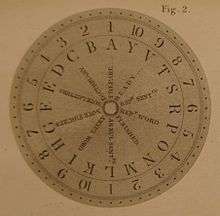
First working systems
The first working telegraph was built by the English inventor Francis Ronalds in 1816 and used static electricity.[11][12] At the family home on Hammersmith Mall, he set up a complete subterranean system in a 175 yard long trench as well as an eight mile long overhead telegraph. The lines were connected at both ends to revolving dials marked with the letters of the alphabet and electrical impulses sent along the wire were used to transmit messages. Offering his invention to the Admiralty in July 1816, it was rejected as "wholly unnecessary".[13] His account of the scheme and the possibilities of rapid global communication in Descriptions of an Electrical Telegraph and of some other Electrical Apparatus[14] was the first published work on electric telegraphy and even described the risk of signal retardation due to induction.[15] Elements of Ronalds’ design were utilised in the subsequent commercialisation of the telegraph over 20 years later.[16]
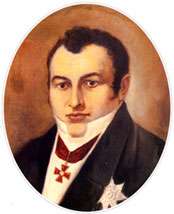
The telegraph invented by Baron Schilling von Canstatt in 1832 had a transmitting device which consisted of a keyboard with 16 black-and-white keys.[17] These served for switching the electric current. The receiving instrument consisted of six galvanometers with magnetic needles, suspended from silk threads. Both stations of Schilling's telegraph were connected by eight wires; six were connected with the galvanometers, one served for the return current and one for a signal bell. When at the starting station the operator pressed a key, the corresponding pointer was deflected at the receiving station. Different positions of black and white flags on different disks gave combinations which corresponded to the letters or numbers. Pavel Schilling subsequently improved its apparatus. He reduced the number of connecting wires from eight to two.
On 21 October 1832, Schilling managed a short-distance transmission of signals between two telegraphs in different rooms of his apartment. In 1836, the British government attempted to buy the design but Schilling instead accepted overtures from Nicholas I of Russia. Schilling's telegraph was tested on a 5-kilometre-long (3.1 mi) experimental underground and underwater cable, laid around the building of the main Admiralty in Saint Petersburg and was approved for a telegraph between the imperial palace at Peterhof and the naval base at Kronstadt. However, the project was cancelled following Schilling's death in 1837.[18] Schilling was also one of the first to put into practice the idea of the binary system of signal transmission.
In 1833, Carl Friedrich Gauss, together with the physics professor Wilhelm Weber in Göttingen installed a 1,200-metre-long (3,900 ft) wire above the town's roofs. Gauss combined the Poggendorff-Schweigger multiplicator with his magnetometer to build a more sensitive device, the galvanometer. To change the direction of the electric current, he constructed a commutator of his own. As a result, he was able to make the distant needle move in the direction set by the commutator on the other end of the line.
At first, Gauss and Weber used the telegraph to coordinate time, but soon they developed other signals; finally, their own alphabet. The alphabet was encoded in a binary code which was transmitted by positive or negative voltage pulses which were generated by means of moving an induction coil up and down over a permanent magnet and connecting the coil with the transmission wires by means of the commutator. The page of Gauss' laboratory notebook containing both his code and the first message transmitted, as well as a replica of the telegraph made in the 1850s under the instructions of Weber are kept in the faculty of physics at the University of Göttingen, in Germany.
Gauss was convinced that this communication would be a help to his kingdom's towns. Later in the same year, instead of a Voltaic pile, Gauss used an induction pulse, enabling him to transmit seven letters a minute instead of two. The inventors and university were too poor to develop the telegraph on their own, but they received funding from Alexander von Humboldt. Carl August Steinheil in Munich was able to build a telegraph network within the city in 1835-6. He installed a telegraph line along the first German railroad in 1835.
In 1836, an American scientist, Dr. David Alter, invented the first known American electric telegraph, in Elderton, Pennsylvania, one year before the Cooke and Wheatstone and Morse telegraphs. Alter demonstrated it to witnesses but never developed the idea into a practical system.[19] When Alter was interviewed for the book Biographical and Historical Cyclopedia of Indiana and Armstrong Counties, he said: "I may say that there is no connection at all between the telegraph of Morse and others and that of myself.... Professor Morse most probably never heard of me or my Elderton telegraph."
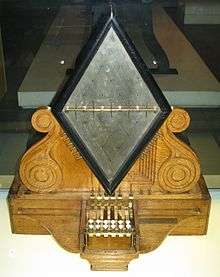
The Cooke and Wheatstone telegraph, was co-developed by William Fothergill Cooke and Charles Wheatstone. In May 1837 they patented a telegraph system which used a number of needles on a board that could be moved to point to letters of the alphabet. Any number of needles could be used, depending on the number of characters it was required to code. The patent recommended five needles.
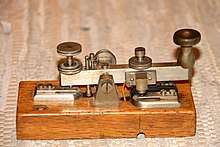
Samuel Morse independently developed and patented a recording electric telegraph in 1837. Morse's assistant Alfred Vail developed an instrument that was called the register for recording the received messages. It embossed dots and dashes on a moving paper tape by a stylus which was operated by an electromagnet.[20] Morse and Vail developed the Morse code signalling alphabet. The first telegram in the United States was sent by Morse on 11 January 1838, across two miles (3 km) of wire at Speedwell Ironworks near Morristown, New Jersey, although it was only later, in 1844, that he sent the message "WHAT HATH GOD WROUGHT" over the 44 miles (71 km) from the Capitol in Washington to the old Mt. Clare Depot in Baltimore.[21][22]
Commercial telegraphy
Cooke and Wheatstone system
The first commercial electrical telegraph, was the Cooke and Wheatstone system. Although the patent recommended a five-needle system, its first commercial use was of a four-needle system that was installed on part of the London and Birmingham Railway being constructed by Robert Stephenson. It connected Euston railway station and Camden Town, and was successfully demonstrated on 25 July 1837.[23] Euston needed to signal to an engine house at Camden Town to start hauling the locomotive up the incline. As at Liverpool, the electric telegraph was in the end rejected in favour of a pneumatic system with whistles.[24]
Cooke and Wheatstone had their first commercial success with a system installed on the Great Western Railway over the 13 miles (21 km) from Paddington station to West Drayton in 1838.[25] This was a five-needle, six-wire[24] system. The cables were originally installed underground in a steel conduit. However, the cables soon began to fail as a result of deteriorating insulation and were replaced with uninsulated wires on poles.,[26][27] As an interim measure, a two-needle system was used with three of the remaining working underground wires, which despite using only two needles had a greater number of codes.[28] But when the line was extended to Slough in 1843, a one-needle, two-wire system was installed.[29]
From this point the use of the electric telegraph started to grow on the new railways being built from London. The London and Blackwall Railway (another rope-hauled application) was equipped with the Cooke and Wheatstone telegraph when it opened in 1840, and many others followed.[27] The one-needle telegraph proved highly successful on British railways, and 15,000 sets were still in use at the end of the nineteenth century. Some remained in service in the 1930s.[30] In September 1845 the financier John Lewis Ricardo and Cooke formed the Electric Telegraph Company, the first public telegraphy company in the world. This company bought out the Cooke and Wheatstone patents and solidly established the telegraph business.[31][32]
Morse system
In the United States, the Morse/Vail telegraph was quickly deployed in the two decades following the first demonstration. The overland telegraph connected the west coast of the continent to the east coast by 24 October 1861, bringing an end to the Pony Express.[33]
As well as the rapid expansion of the use of the telegraphs along the railways, they soon spread into the field of mass communication with the instruments being installed in post offices. The era of mass personal communication had begun.
Telegraphic improvements
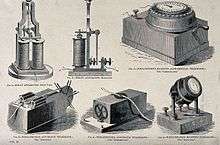
A continuing goal in telegraphy was to reduce the cost per message by reducing hand-work, or increasing the sending rate. There were many experiments with moving pointers, and various electrical encodings. However, most systems were too complicated and unreliable. A successful expedient to reduce the cost per message was the development of telegraphese.
The first system that didn't require skilled technicians to operate, was Charles Wheatstone's ABC system in 1840 where the letters of the alphabet were arranged around a clock-face, and the signal caused a needle to indicate the letter. This early system required the receiver to be present in real time to record the message and it reached speeds of up to 15 words a minute.
In 1846, Alexander Bain patented a chemical telegraph in Edinburgh. The signal current moved an iron pen across a moving paper tape soaked in a mixture of ammonium nitrate and potassium ferrocyanide, decomposing the chemical and producing readable blue marks in Morse code. The speed of the printing telegraph was 1000 words per hour, but messages still required translation into English by live copyists. Chemical telegraphy came to an end in the US in 1851, when the Morse group defeated the Bain patent in the US District Court.[34]
For a brief period, starting with the New York-Boston line in 1848, some telegraph networks began to employ sound operators, who were trained to understand Morse code aurally. Gradually, the use of sound operators eliminated the need for telegraph receivers to include register and tape. Instead, the receiving instrument was developed into a "sounder", an electromagnet that was energized by a current and attracted a small iron lever. When the sounding key was opened or closed, the sounder lever struck an anvil. The Morse operator distinguished a dot and a dash by the short or long interval between the two clicks. The message was then written out in long-hand.[35]
Royal Earl House developed and patented a letter-printing telegraph system in 1846 which employed an alphabetic keyboard for the transmitter and automatically printed the letters on paper at the receiver,[36] and followed this up with a steam-powered version in 1852.[37] Advocates of printing telegraphy said it would eliminate Morse operators' errors. The House machine was used on four main American telegraph lines by 1852. The speed of the House machine was announced as 2600 words an hour.[38]

David Edward Hughes invented the printing telegraph in 1855; it used a keyboard of 26 keys for the alphabet and a spinning type wheel that determined the letter being transmitted by the length of time that had elapsed since the previous transmission. The system allowed for automatic recording on the receiving end. The system was very stable and accurate and became accepted around the world.[39]
The next improvement was the Baudot code of 1874. French engineer Émile Baudot patented a printing telegraph in which the signals were translated automatically into typographic characters. Each character was assigned a five-bit code, mechanically interpreted from the state of five on/off switches. Operators had to maintain a steady rhythm, and the usual speed of operation was 30 words per minute.[40]
By this point reception had been automated, but the speed and accuracy of the transmission was still limited to the skill of the human operator. The first practical automated system was patented by Charles Wheatstone, the original inventor of the telegraph. The message (in Morse code) was typed onto a piece of perforated tape using a keyboard-like device called the 'Stick Punch'. The transmitter automatically ran the tape through and transmitted the message at the then exceptionally high speed of 70 words per minute.
Teleprinters
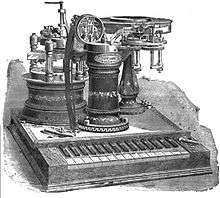
An early successful teleprinter was invented by Frederick G. Creed. In Glasgow he created his first keyboard perforator, which used compressed air to punch the holes. He also created a reperforator (receiving perforator) and a printer. The reperforator punched incoming Morse signals on to paper tape and the printer decoded this tape to produce alphanumeric characters on plain paper. This was the origin of the Creed High Speed Automatic Printing System, which could run at an unprecedented 200 words per minute. His system was adopted by the Daily Mail for daily transmission of the newspaper contents.
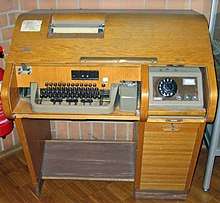
With the invention of the teletypewriter, telegraphic encoding became fully automated. Early teletypewriters used the ITA-1 Baudot code, a five-bit code. This yielded only thirty-two codes, so it was over-defined into two "shifts", "letters" and "figures". An explicit, unshared shift code prefaced each set of letters and figures.
By the 1930s teleprinters were being produced by Teletype in the US, Creed in Britain and Siemens in Germany.

By 1935, message routing was the last great barrier to full automation. Large telegraphy providers began to develop systems that used telephone-like rotary dialling to connect teletypewriters. These machines were called "Telex" (TELegraph EXchange). Telex machines first performed rotary-telephone-style pulse dialling for circuit switching, and then sent data by ITA2. This "type A" Telex routing functionally automated message routing.
The first wide-coverage Telex network was implemented in Germany during the 1930s as a network used to communicate within the government.
At the rate of 45.45 (±0.5%) baud — considered speedy at the time — up to 25 telex channels could share a single long-distance telephone channel by using voice frequency telegraphy multiplexing, making telex the least expensive method of reliable long-distance communication.
Automatic teleprinter exchange service was introduced into Canada by CPR Telegraphs and CN Telegraph in July 1957 and in 1958, Western Union started to build a Telex network in the United States.[41]
The harmonic telegraph
The most expensive aspect of a telegraph system was the installation – the laying of the wire, which was often very long. The costs would be better covered by finding a way to send more than one message at a time through the single wire, thus increasing revenue per wire. In the latter half of the 1800s, several inventors worked towards creating a method for doing just that, including: Charles Bourseul, Thomas Edison, Elisha Gray, and Alexander Graham Bell. One approach was to have oscillators of several different frequencies act as carriers of a modulated on-off signal (see frequency-division multiplexing). These various frequencies, referred to as harmonics, could then be combined into one complex signal and sent down the single wire. On the receiving end, the frequencies would be separated with a matching set of oscillators. With a set of frequencies being carried down a single wire, it was realized that the human voice itself could be transmitted electrically through the wire. This effort led to the invention of the telephone. (While the work toward packing multiple telegraph signals onto one wire led to telephony, later advances would pack multiple voice signals onto one wire by increasing the bandwidth by modulating frequencies much higher than human hearing. Eventually the bandwidth was widened much further by using laser light signals sent through fiber optic cables. Fiber optic transmission can carry thousands of telegraph signals simultaneously down a single line.)
Oceanic telegraph cables
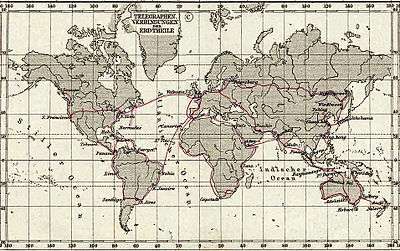
Soon after the first successful telegraph systems were operational, the possibility of transmitting messages across the sea by way of submarine communications cables was first proposed. One of the primary technical challenges was to sufficiently insulate the submarine cable to prevent the current from leaking out into the water. In 1842, a Scottish surgeon William Montgomerie[42] introduced gutta-percha, the adhesive juice of the Palaquium gutta tree, to Europe. Michael Faraday and Wheatstone soon discovered the merits of gutta-percha as an insulator, and in 1845, the latter suggested that it should be employed to cover the wire which was proposed to be laid from Dover to Calais. It was tried on a wire laid across the Rhine between Deutz and Cologne. In 1849, C.V. Walker, electrician to the South Eastern Railway, submerged a two-mile wire coated with gutta-percha off the coast from Folkestone, which was tested successfully.[42]
John Watkins Brett, an engineer from Bristol, sought and obtained permission from Louis-Philippe in 1847 to establish telegraphic communication between France and England. The first undersea cable was laid in 1850, connecting the two countries and was followed by connections to Ireland and the Low Countries.
The Atlantic Telegraph Company was formed in London in 1856 to undertake to construct a commercial telegraph cable across the Atlantic Ocean. It was successfully completed on 18 July 1866 by the ship SS Great Eastern, captained by Sir James Anderson after many mishaps along the away.[43] Earlier transatlantic submarine cables installations were attempted in 1857, 1858 and 1865. The 1857 cable only operated intermittently for a few days or weeks before it failed. The study of underwater telegraph cables accelerated interest in mathematical analysis of very long transmission lines. The telegraph lines from Britain to India were connected in 1870 (those several companies combined to form the Eastern Telegraph Company in 1872).
Australia was first linked to the rest of the world in October 1872 by a submarine telegraph cable at Darwin.[44] This brought news reportage from the rest of the world.[45] The telegraph across the Pacific was completed in 1902, finally encircling the world.
From the 1850s until well into the 20th century, British submarine cable systems dominated the world system. This was set out as a formal strategic goal, which became known as the All Red Line.[46] In 1896, there were thirty cable laying ships in the world and twenty-four of them were owned by British companies. In 1892, British companies owned and operated two-thirds of the world's cables and by 1923, their share was still 42.7 percent.[47]
Cable and Wireless Company
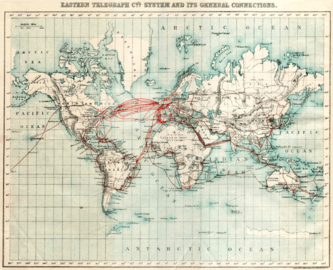
Cable & Wireless was a British telecommunications company that traced its origins back to the 1860s, with Sir John Pender as the founder,[48] although the name was only adopted in 1934. It was formed from successive mergers including:
Telegraphy in war
Before the American Civil War, the telegraph systems were primarily used in the commercial sector. The Government buildings weren't connected to each other via telegraph lines, but instead relied on runners to carry messages back and forth between buildings and offices.[51] Before the war the Government saw no need to connect lines within city limits, however, they did see the use in connections between cities. With Washington D.C. being the hub of the American Government, it had the most connections, but it only had a few lines running north and south out of the city.[51][52] It wasn't until the Civil War broke out that the Government saw the true potential of the telegraph system. Soon after the shelling of Fort Sumter, the South cut telegraph lines running into D.C. This put the city in a state of panic for they feared an immediate southern invasion.[52][51]
Due to its large and robust telegraph system, as well as its industrial base, the North had a large advantage over the South during the course of the War.[52] Within 6 months of the war breaking out, the U.S. Military Telegraph Corps (USMT) had laid approximately 300 miles of line. By war's end they laid approximately 15,000 miles of cable, 8,000 for military and 5,000 for commercial, and had handled approximately 6.5 million messages.[52] The telegraph was not only important for communication within the armed forces, but also in the civilian sector, helping political leaders to maintain control over their districts.[52]
Even before the war, the American Telegraph Company censored suspect messages informally to block aid to the secession movement.
During the war, Secretary of War, Simon Cameron, and later Edwin Stanton, wanted control over the telegraph lines to maintain the flow of information. Early in the war, one of Stanton's first acts of Secretary of War, was to move telegraph lines from ending at McClellan's headquarters to ending at the War Department. Even Stanton himself said "[telegraph] is my right arm".[52] Many Northern victories were found due to the use of the telegraph. Victories include the Battle of Antietam (1862), the Battle of Chickamauga (1863), and Sherman's March (1865).[52]
The telegraph system wasn't without its flaws. The USMT, while the main source of telegraphers and cable, was still a civilian agency. Most operators were first hired by the telegraph companies and then contracted out to the War Department. This created tension between Generals and their operators.[52] One source of irritation was that USMT operators didn't have to follow military authority, they usually performed without hesitation, but they didn't have to.[52] To remedy this problem Albert Myer created a U.S. Army Signal Corps in February 1863. As the new head of the Signal Corps, Myer tried to push all telegraph and flag signaling under his command, and therefore subject to military discipline.[52] After creating the Signal Corps, Myer pushed to further develop new telegraph systems. While the USMT relied primarily on civilian lines and operators, the Signal Corp's new field telegraph could be deployed and dismantled faster than USMT's system.[52]
During World War I, Britain's telegraph communications were almost completely uninterrupted, while it was able to quickly cut Germany's cables worldwide.[46] British access to transatlantic cables and its codebreaking expertise led to the Zimmermann Telegram incident that contributed to the US joining the war.[53]
World War II revived the 'cable war' of 1914-1918. In 1939, German-owned cables across the Atlantic were cut once again, and, in 1940, Italian cables to South America and Spain were cut in retaliation for Italian action against two of the five British cables linking Gibraltar and Malta. Electra House, Cable & Wireless's head office and central cable station, was damaged by German bombing in 1941.[54]
End of the telegraph era
In America, the end of the telegraph era can be associated with the fall of the Western Union Telegraph Company.[52] Western Union was the leading telegraph provider for America and was seen as the best competition for the National Bell Telephone Company. Western Union and Bell were both invested in telegraphy and telephone technology. Western Union's decision to allow Bell to gain the advantage in telephone technology was the result of Western Union's upper management's failure to foresee the surpassing of the telephone over the, at the time, dominant telegraph system.[52] Western Union soon lost the legal battle for the rights to their telephone copyrights. This led to Western Union agreeing to a lesser position in the telephone competition, which in turn led to the lessening of the telegraph.[52]
While the telegraph was not the focus of the legal battles that occurred around 1878, the companies that were affected by the effects of the battle were the main powers of telegraphy at the time.[52] Western Union thought that the agreement of 1878 would solidify telegraphs as the long-range communication of choice.[52] However, due to the underestimates of telegraph's future and poor contracts, Western Union found itself declining.[52] AT&T acquired working control of Western Union in 1909 but relinquished it in 1914 under threat of antitrust action. AT&T bought Western Union's electronic mail and Telex businesses in 1990.
India's state-owned telecom company, BSNL, ended its telegraph service on 14 July 2013. It was reportedly the world's last existing true electric telegraph system.[55][56]
See also
- 92 Code
- Aurora (astronomy)
- Geomagnetically induced current
- Great Northern Telegraph Company
- Harrison Gray Dyar, who supposedly erected the first telegraph line and dispatched the first telegram
- Neutral direct-current telegraph system
- Submarine communications cable
- Western Electric Company
- Wireless telegraphy
- American Telephone and Telegraph Company (AT&T)
- Bell Canada
- Guglielmo Marconi
- Marconi Wireless Company
References
- ↑ E. A. Marland, Early Electrical Communication, Abelard-Schuman Ltd, London 1964, no ISBN, Library of Congress 64-20875, pages 17-19;
- ↑ Prevost, 1805, pp. 176-178
- 1 2 Jones, R. Victor Samuel Thomas von Sömmering's "Space Multiplexed" Electrochemical Telegraph (1808-10), Harvard University website. Attributed to "Semaphore to Satellite" , International Telecommunication Union, Geneva 1965. Retrieved 2009-05-01
- ↑ M. (10 December 2014). Schweigger Multiplier – 1820. Retrieved 7 February 2018, from https://nationalmaglab.org/education/magnet-academy/history-of-electricity-magnetism/museum/schweigger-multiplier
- ↑ R. V. G. Menon (2011). Technology and Society. India: Dorling Kindersley.
- ↑ Henry Pitt Phelps (1884). The Albany Hand-book: A Strangers' Guide and Residents' Manual. Albany: Brandow & Barton. p. 6.
- ↑ Gibberd, William (1966). "Edward Davy". Australian Dictionary of Biography. Canberra: Australian National University. Retrieved 7 June 2012.
- ↑ "Joseph Henry: Inventor of the Telegraph? Smithsonian Institution". Archived from the original on 2006-06-26. Retrieved 2006-06-29.
- ↑ Thomas Coulson (1950). Joseph Henry: His Life and Work. Princeton: Princeton University Press.
- ↑ "Edward Davy". Australian Science Archives Project. Retrieved 7 June 2012.
- ↑ Appleyard, R. (1930). Pioneers of Electrical Communication. Macmillan.
- ↑ Norman, Jeremy. "Francis Ronalds Builds the First Working Electric Telegraph (1816)". HistoryofInformation.com. Retrieved 1 May 2016.
- ↑ Ronalds, B.F. (2016). "Sir Francis Ronalds and the Electric Telegraph". Int. J. for the History of Engineering & Technology. doi:10.1080/17581206.2015.1119481.
- ↑ Ronalds, Francis (1823). Descriptions of an Electrical Telegraph and of some other Electrical Apparatus. London: Hunter.
- ↑ Ronalds, B.F. (Feb 2016). "The Bicentennial of Francis Ronalds's Electric Telegraph". Physics Today. doi:10.1063/PT.3.3079.
- ↑ Ronalds, B.F. (2016). Sir Francis Ronalds: Father of the Electric Telegraph. London: Imperial College Press. ISBN 978-1-78326-917-4.
- ↑ Fahie, John Jacob (1884). A History of Electric Telegraphy, to the Year 1837 (PDF). E. & F.N. Spon. pp. 307–319. Retrieved 21 November 2017.
- ↑ Huurdeman 2003, p. 54.
- ↑ Popular Science, February 1882, vol.20, no.28, p.568, Bonnier Corporation, ISSN 0161-7370.
- ↑ Calvert 2008.
- ↑ Howe, p. 7
- ↑ History.com Staff (2009), Morse Code & the Telegraph, A+E Networks
- ↑ The telegraphic age dawns BT Group Connected Earth Online Museum. Accessed December 2010, archived 10 Feb 2013
- 1 2 Bowers, page 129
- ↑ Huurdeman 2003, p. 67.
- ↑ Huurdeman 2003, pp. 67–68.
- 1 2 Beauchamp 2001, p. 35.
- ↑ Mercer, page 7
- ↑ Huurdeman 2003, p. 69.
- ↑ Huurdeman 2003, pp. 67-69.
- ↑ Nichols, John (1967). The Gentleman's magazine, Volumes 282–283. p. 545. University of California
- ↑ Paul Atterbury. "Victorian Technology". BBC.
- ↑ Today in History - 24 October, The Transcontinental Telegraph and the End of the Pony Express, Library of Congress, retrieved 3 February 2017.
- ↑ Oslin, George P. The Story of Telecommunications, Mercer University Press, 1992. 69.
- ↑ Oslin, George P. The Story of Telecommunications. Mercer University Press, 1992. 67
- ↑ "Royal Earl House Printing-Telegraph Patent #4464, 1846". Retrieved 2014-04-25.
- ↑ "Royal Earl House Steam-Powered Printing-Telegraph Patent #9505, 1852". Retrieved 2014-04-25.
- ↑ Oslin, George, P. The Story of Telecommunications, 1992. 71
- ↑ "David Edward Hughes". Clarkson University. 14 April 2007. Archived from the original on 2008-04-22. Retrieved 2010-09-29.
- ↑ Beauchamp 2001, pp. 394–395.
- ↑ Phillip R. Easterlin, "Telex in New York", Western Union Technical Review, April 1959: 45
- 1 2 Haigh, K R (1968). Cable Ships and Submarine Cables. London: Adlard Coles Ltd. pp. 26–27.
- ↑ Wilson, Arthur (1994). The Living Rock: The Story of Metals Since Earliest Times and Their Impact on Civilization. p. 203. Woodhead Publishing. ISBN 978-1-85573-301-5.
- ↑ Briggs, Asa and Burke, Peter: "A Social History of the Media: From Gutenberg to the Internet", p110. Polity, Cambridge, 2005.
- ↑ Conley, David and Lamble, Stephen (2006) The Daily Miracle: An introduction to Journalism,(Third Edition) Oxford University Press, Australia pp. 305-307
- 1 2 Kennedy, P. M. (October 1971). "Imperial Cable Communications and Strategy, 1870-1914". The English Historical Review. 86 (341): 728–752. doi:10.1093/ehr/lxxxvi.cccxli.728. JSTOR 563928.
- ↑ Headrick, D.R., & Griset, P. (2001). Submarine telegraph cables: business and politics, 1838-1939. The Business History Review, 75(3), 543-578.
- ↑ Sir John Pender
- ↑ Evolution of Eastern Telegraph Company
- ↑ Origins of the Eastern & Associated Telegraph Companies
- 1 2 3 Schwoch, James (2018). Wired into Nature: The Telegraph and the North American Frontier. University of Illinois Press. ISBN 9780252041778.
- 1 2 3 4 5 6 7 8 9 10 11 12 13 14 15 16 17 Hochfelder, David (2012). The Telegraph in America, 1832-1920. Johns Hopkins University Press. pp. 6–17, 138–141. ISBN 9781421407470.
- ↑ "The telegram that brought America into the First World War". BBC History Magazine. 17 January 2017. Retrieved 17 January 2017.
- ↑ Company-Histories.com Cable and Wireless plc Source: International Directory of Company Histories, Vol. 25. St. James Press, 1999.
- ↑ "No farewell to telegram in Goa as BSNL takes day off". The Times of India. 15 July 2013. Retrieved 15 July 2013.
- ↑ "World's last telegram to be sent next month". USA Today. 15 June 2013. Retrieved 14 July 2013.
Bibliography
- Beauchamp, Ken (2001), History Of Telegraphy, London: The Institution Of Electrical Engineers, ISBN 978-0-85296-792-8
- Bowers, Brian, Sir Charles Wheatstone: 1802–1875, IET, 2001 ISBN 0852961030.
- Calvert, J. B. (2008), The Electromagnetic Telegraph
- Huurdeman, Anton A. (2003), The Worldwide History of Telecommunications, Wiley-Blackwell, ISBN 978-0471205050
- Mercer, David, The Telephone: The Life Story of a Technology, Greenwood Publishing Group, 2006 ISBN 031333207X.
Further reading
- Cooke, W.F., The Electric Telegraph, Was it invented by Prof. Wheatstone?, London 1856.
- Gray, Thomas (1892). "The Inventors Of The Telegraph And Telephone". Annual Report of the Board of Regents of the Smithsonian Institution. 71: 639–659. Retrieved 2009-08-07.
- Gauß, C. F., Works, Göttingen 1863-1933.
- Howe, Daniel Walker, What Hath God Wrought: The Transformation of America, 1815-1848, Oxford University Press, 2007 ISBN 0199743797.
- Peterson, M.J. Roots of Interconnection: Communications, Transportation and Phases of the Industrial Revolution, International Dimensions of Ethics Education in Science and Engineering Background Reading, Version 1; February 2008.
- Steinheil, C.A., Ueber Telegraphie, München 1838.
- Wiley, Samuel T. (ed.), Biographical and Historical Cyclopedia of Indiana and Armstrong Counties, John M. Gresham and Co., Philadelphia PA, 1891, pages 475-476.
- Yates, JoAnne. The Telegraph's Effect on Nineteenth Century Markets and Firms, Massachusetts Institute of Technology, pp. 149–163.
External links
| Wikisource has original text related to this article: |
- Morse Telegraph Club, Inc. (The Morse Telegraph Club is an international non-profit organization dedicated to the perpetuation of the knowledge and traditions of telegraphy.)
- http://collections.ic.gc.ca/canso/index.htm
- Shilling's telegraph, an exhibit of the A.S. Popov Central Museum of Communications
- History of electromagnetic telegraph
- The first electric telegraphs
- The Dawn of Telegraphy (in Russian)
- Pavel Shilling and his telegraph- article in PCWeek, Russian edition.
- Distant Writing - The History of the Telegraph Companies in Britain between 1838 and 1868
- NASA - Carrington Super Flare NASA 6 May 2008
- How Cables Unite The World - a 1902 article about telegraph networks and technology from the magazine The World's Work
